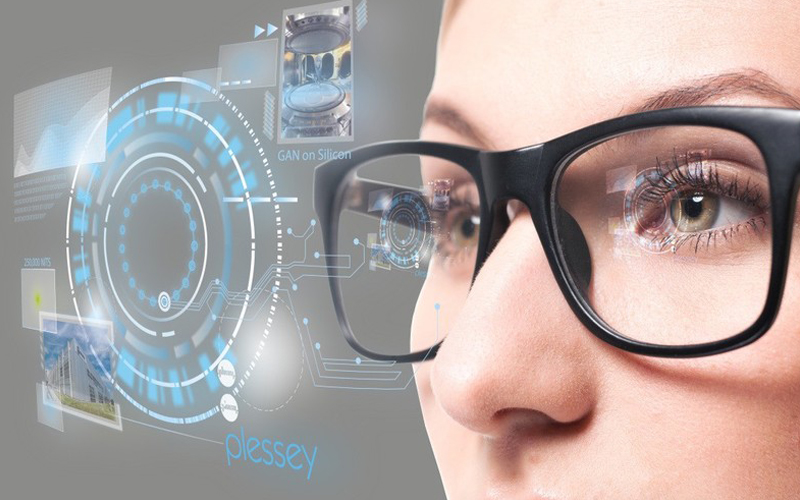AI glasses are revolutionizing the way people interact with technology by displaying information directly in their line of sight. These smart wearables combine advanced augmented reality (AR), artificial intelligence (AI), and computer vision to recognize objects, read text, and even translate languages in real time.
In this article, we’ll explore how AI glasses function, breaking down their key components, real-world applications, and the exciting future of this technology.

What Are AI Glasses?
AI glasses, also known as smart glasses, blend traditional eyewear with high-tech capabilities. Equipped with cameras, sensors, microphones, and AR displays, they provide users with hands-free access to digital information.
Core Features of AI Glasses:
✅ Real-time object recognition – Identify objects and provide relevant information.
✅ Live translation – Convert spoken or written languages instantly.
✅ Hands-free calls & notifications – Answer calls or receive updates without looking at a phone.
✅ Augmented reality overlays – Merge digital elements with real-world views.
✅ Remote assistance – Enable professionals to guide users in real time.
AI glasses are transforming industries like healthcare, manufacturing, education, and retail, offering both productivity and accessibility benefits.
How AI Glasses Work: Key Technologies

1. Display Technology
AI glasses use micro-displays and AR projection systems to present digital content directly in the user’s field of view. These displays overlay information without blocking real-world vision, making them ideal for navigation, remote work, and entertainment.
🔹 Types of Displays Used in AI Glasses:
-
OLED/Micro-OLED displays – Offer high brightness and contrast for outdoor visibility.
-
Waveguide projection – Projects images onto transparent lenses for seamless AR integration.
-
Holographic optics – Provides a 3D-like effect for immersive experiences.
2. Sensors & Cameras
AI glasses rely on advanced sensors to interact with the environment. These include:
-
Cameras – Capture images and videos for real-time analysis.
-
Motion sensors (gyroscope, accelerometer, GPS) – Track head movements and positioning.
-
Depth sensors & LiDAR – Map surroundings for AR applications.
These components allow AI glasses to detect facial expressions, gestures, and objects, enabling hands-free interaction.
3. AI-Powered Software & Microprocessors
AI glasses integrate machine learning algorithms to process data quickly. The onboard processor manages tasks such as:
-
Voice recognition – Enables hands-free commands.
-
Image and text processing – Reads and interprets information in real time.
-
Augmented reality mapping – Projects virtual objects onto real-world surfaces.
The software connects with cloud services and smartphone apps, ensuring seamless communication and updates.
4. Connectivity & Integration
AI glasses sync with smartphones, tablets, and smart devices via:
🔹 Wi-Fi & Bluetooth – Enables real-time updates and notifications.
🔹 Cloud storage – Stores captured data securely.
🔹 App compatibility – Connects with productivity, navigation, and entertainment apps.
This connectivity allows AI glasses to function as an extension of smartphones, offering users a hands-free, interactive experience.
How AI Glasses Enhance Daily Life
AI glasses aren’t just for tech enthusiasts—they provide practical benefits across various industries and everyday activities.
1. Augmented Reality in Daily Tasks
🔹 Navigation & Mapping – Displays real-time directions, points of interest, and traffic updates.
🔹 Live Translation – Converts text and speech into different languages instantly.
🔹 Smart Notifications – Reads messages, reminders, and alerts hands-free.
2. Professional Applications
✔️ Healthcare – Doctors can view patient records and perform remote consultations.
✔️ Manufacturing – Workers receive step-by-step AR instructions, improving efficiency.
✔️ Education – Students and teachers interact with 3D educational content.
✔️ Retail – Sales associates access inventory details and customer preferences in real time.
3. Entertainment & Social Experiences
🎮 Gaming & Virtual Reality – Enhances gameplay with immersive AR elements.
🎥 Live Streaming & Content Creation – Captures moments hands-free.
🎭 Concerts & Sports Events – Provides real-time stats and interactive overlays.
Challenges & Limitations of AI Glasses
1. Privacy & Security Risks
AI glasses collect and process vast amounts of data, raising concerns about user privacy. To address this, manufacturers are implementing:
-
Encrypted storage & transmission – Protects user information.
-
LED indicators – Notify others when recording is active.
-
User control settings – Allow customization of data collection preferences.
2. Battery Life Constraints
🔋 AI glasses consume power quickly due to high-performance displays, sensors, and connectivity features.
💡 Solutions:
-
Energy-efficient processors optimize battery usage.
-
Portable charging cases extend daily usability.
-
Adaptive brightness settings reduce power consumption.
3. Bulkiness & Comfort Issues
Early AI glasses designs were bulky and heavy, limiting long-term wearability. However, newer models are becoming lighter, sleeker, and more ergonomic, ensuring better comfort and style.
The Future of AI Glasses
As AI and AR technologies continue to advance, AI glasses are expected to become more powerful, lightweight, and affordable.
🔹 Upcoming Innovations in AI Glasses:
-
AI-powered virtual assistants – Improve real-time interaction.
-
More compact & stylish designs – Increase adoption among general consumers.
-
Advanced eye-tracking & gesture control – Enables hands-free operation.
-
Seamless integration with smart home & IoT devices – Enhances automation and convenience.
With continued advancements, AI glasses have the potential to become as essential as smartphones, transforming how people interact with the digital world.
Conclusion
AI glasses bridge the gap between the digital and physical worlds, offering augmented reality, voice recognition, and AI-driven insights in real time. As industries explore new applications, these smart wearables are becoming valuable tools for work, learning, and entertainment.
With improvements in privacy, battery life, and comfort, AI glasses are on the path to mass adoption, making everyday life smarter, more efficient, and more immersive. Knowing more at Optics Town Optical Wholesaler.




